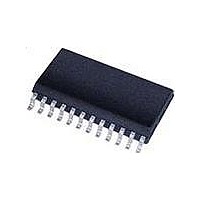SP207EEA-L Exar Corporation, SP207EEA-L Datasheet - Page 5

SP207EEA-L
Manufacturer Part Number
SP207EEA-L
Description
IC TXRX RS232 ESD LP 24SSOP
Manufacturer
Exar Corporation
Type
Transceiverr
Datasheet
1.SP213ECA-L.pdf
(19 pages)
Specifications of SP207EEA-L
Package / Case
24-SSOP (0.200", 5.30mm Width)
Number Of Drivers/receivers
5/3
Protocol
RS232
Voltage - Supply
4.5 V ~ 5.5 V
Mounting Type
Surface Mount
On Resistance (max)
7 KOhms
Propagation Delay Time
1.5 us
Maximum Operating Temperature
+ 85 C
Minimum Operating Temperature
- 40 C
Function
Transceiver
Mounting Style
SMD/SMT
Supply Current
3 mA
Supply Voltage (max)
6 V
Supply Voltage (min)
5 V
Logic Type
RS-232 Transceivers
Number Of Circuits
3
Lead Free Status / RoHS Status
Lead free / RoHS Compliant
Lead Free Status / RoHS Status
Lead free / RoHS Compliant, Lead free / RoHS Compliant
Available stocks
Company
Part Number
Manufacturer
Quantity
Price
Company:
Part Number:
SP207EEA-L
Manufacturer:
Exar
Quantity:
135
Company:
Part Number:
SP207EEA-L
Manufacturer:
MOTOROLA
Quantity:
2 000
Company:
Part Number:
SP207EEA-L/TR
Manufacturer:
PANASONIC
Quantity:
6 219
FEATuRES
The SP207E, SP208E, SP211E and
SP213E multi–channel transceivers fit most
RS-232/V.28 communication needs. All of
these devices feature low–power CMOS con-
struction and ExAR–proprietary on-board
charge pump circuitry to generate RS-232
signal-voltages, making them ideal for appli-
cations where +9V and -9V supplies are not
available. The highly efficient charge pump
is optimized to use small and inexpensive
0.µF charge pump capacitors, saving board
space and reducing overall circuit cost.
Each device provides a different driver/
receiver combination to match standard
application requirements. The SP207E is
a 5-driver, 3-receiver device, ideal for DCE
applications such as modems, printers or
other peripherals. SP208E is a 4-driver/4-
receiver device, ideal for providing hand-
shaking signals in V.35 applications or other
general-purpose serial communications.
The SP211E and SP213E are each 3-driver,
5-receiver devices ideal for DTE serial ports
on a PC or other data-terminal equipment.
The SP211E and SP213E feature a low–
power shutdown mode, which reduces power
supply drain to µA. The SP213E includes a
Wake-Up function which keeps two receivers
active in the shutdown mode, unless disabled
by the EN pin.
The family is available in 28 and 24 pin SO
(wide) and SSOP (shrink) small outline pack-
ages. Devices can be specified for commer-
cial (0˚C to +70˚C) and industrial/extended
(–40˚C to +85˚C) operating temperatures.
THEORY OF OPERATION
Exar RS-232 transceivers contain three
basic circuit blocks — a) transmitter/driver,
b) receiver and c) the ExAR–proprietary
charge pump. SP211E and SP213E also
include SHUTDOWN and ENABLE func-
tions.
Exar Corporation 48720 Kato Road, Fremont CA, 94538 • 50-668-707 • www.exar.com
5
Transmitter/Drivers
The drivers are single-ended inverting trans-
mitters, which accept either TTL or CMOS
inputs and output the RS-232 signals with
an inverted sense relative to the input logic
levels. Should the input of the driver be left
open, an internal pullup to V
input high, thus committing the output to a
logic- (MARK) state. The slew rate of the
transmitter output is internally limited to a
maximum of 30V/µs in order to meet the
EIA/RS-232 and ITU V.28 standards. The
transition of the output from high to low also
meets the monotonicity requirements of the
standard even when loaded. Driver output
voltage swing is ±7V (typical) with no load,
and ±5V or greater at maximum load. The
transmitter outputs are protected against
infinite short–circuits to ground without
degradation in reliability.
The drivers of the SP211E, and SP213E
can be tri–stated by using the SHUTDOWN
function. In this “power-off” state the charge
pump is turned off and V
µA typical. Driver output impedance will
remain greater than 300Ω, satisfying the
RS-232 and V.28 specifications. For SP211E
SHUTDOWN is active when pin 25 is driven
high. For SP213E SHUTDOWN is active
when pin 25 is driven low.
Receivers
The receivers convert RS-232 level input
signals to inverted TTL level signals. Because
signals are often received from a transmis-
sion line where long cables and system
interference can degrade signal quality, the
inputs have enhanced sensitivity to detect
weakened signals. The receivers also fea-
ture a typical hysteresis margin of 500mV for
clean reception of slowly transitioning signals
in noisy conditions. These enhancements
ensure that the receiver is virtually immune
to noisy transmission lines.
CC
current drops to
SP207E_00_072309
CC
forces the













